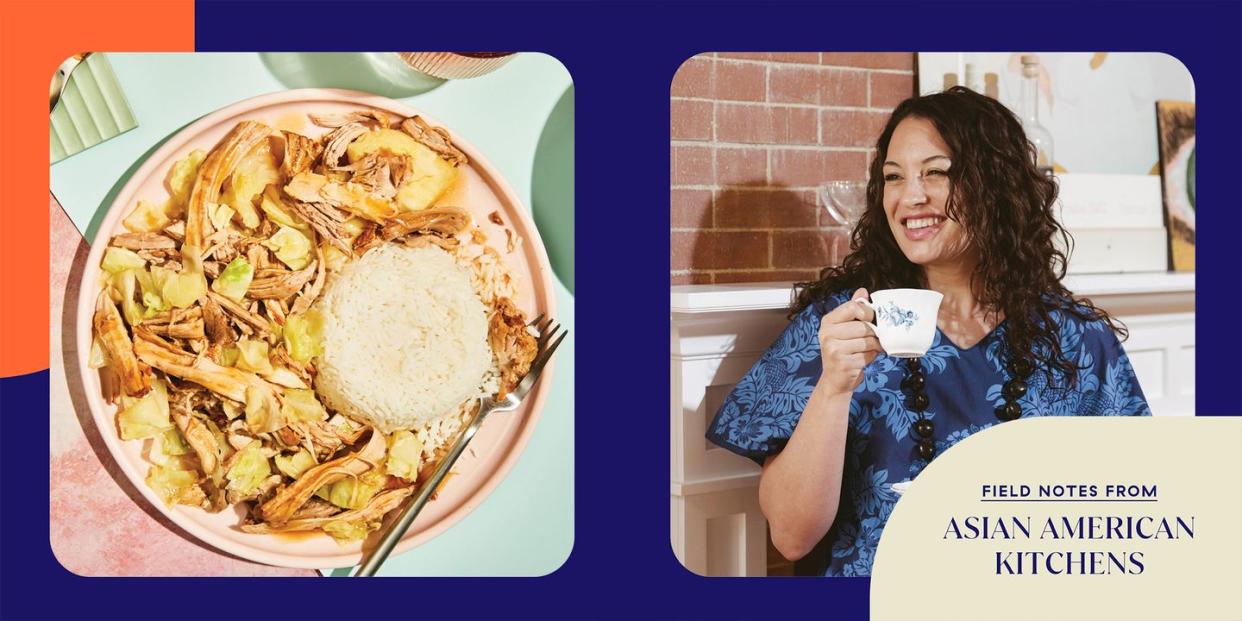Kālua Pig And Cabbage Is As Hawaiian As The Aloha Spirit

Kālua pig and cabbage is just as it sounds—simplicity. A seasoned chef and a first-time cook are both equally qualified to try their hand at making it.
Unlike other dishes that rely on uncommon herbs or pricey cuts of meat, its ingredients are unpretentious. The grocery list for the meal includes only two purchases: a pork butt and a green cabbage head. The other accouterments—Worcestershire sauce, sea salt, black pepper, and shoyu, or soy sauce—are easily found in the fridge and spice cabinet.
The dish is a practice in patience. As the hours tick by, the pig stews in its own juices, and the cabbage wilts. That’s precious time to focus on the side dishes, which no Hawaiian plate can do without. Rice, a cultural cornerstone, gets a spot. There’s also room for a scoop or two of macaroni salad: an undemanding mix of pasta, mayonnaise, apple cider vinegar, and a few more trimmings.
The exact origin of Hawai‘i’s quintessential plate lunch is up for debate. Eater traces it to pineapple and sugar plantation workers in the 1880s. However, an investigation by Arnold Hiura, a former editor of the Hawai‘i Herald, found its roots at Honolulu Harbor in the 1920s-30s, according to his book, Kau Kau: Cuisine and Culture in the Hawaiian Islands.
On the mainland, or continental U.S., the trickiest item to secure is the poi, a paste pounded from taro root. Residents of California, Oregon, and Washington State—which host the highest concentrations of islanders—will likely have an easier time finding the light purple mash, but it can also be found online. Served warm or chilled, it’s an acquired taste, according to friends who tried and failed to enjoy the traditional food.
But, for my mom, all of the above arranged on a combo plate is a one-way ticket to nostalgia, reminiscent of the cooking of her mother, a native of Ke‘anae in Maui, where she and her 14 siblings grew up.
For me, it’s a life preserver in my constant identity crisis as a multiracial American. As a human smorgasbord of white, Hawaiian, and a touch of Chinese, one word describes it best: “hapa,” which means mixed ethnic heritage, typically with Hawaiian or Pacific Islander ancestry. That’s often enough in Hawai‘i, given that 25 percent of the islands’ population identifies as two or more races.
However, on the mainland, it’s a catalyst for further questioning, commonly summed up in three words: “What are you?” Then, a judgment is passed—one is either “too much” or “not enough.” So, kālua pig and cabbage stood as an island of ancestral affirmations in a sea of imposter syndrome. It’s a direct tie to my family lines of Akuna and Kekahuna.
Growing up in the New Orleans suburbs, cultural exposure waited around every corner and simmered in every kitchen. Raised in a food mecca, I learned early on that heritage is an experience best tasted. Attentive diners can discover an entire people’s history on their tongues when they try Louisiana gumbo, Cajun boudin sausage, Vietnamese phở, Italian muffuletta sandwiches, and Creole étouffée.
Thankfully, I was always within reach of my dad’s blood ties to the American South. But, thousands of miles from the Hawaiian islands, the Pelican State was the last place I’d go to immerse myself in my maternal culture. Although palates craving poke—a Hawaiian dish of raw fish, marinated and cubed—can now find a few spots in the Crescent City, kālua pig and cabbage was, and still is, absent from local menus.
So, I savored the bits and pieces of tradition randomly scattered throughout my adolescence. I began to know my kūpuna, or ancestors, in fragments: my middle name, Hawaiian phrases spoken by my mom, the fresh lei worn at school graduations, the mu‘umu‘u dress hanging in the back of my closet. They stared back at me in the mirror, reflected in my lips and dark curls.
Most of all, I delighted in recognizing the flavors of the ‘āina, or the land, in my bowl at dinnertime. After shooing my sister and me out of the kitchen, Mom managed to whip up her favorite family dish using nothing but a crockpot.
She’s not the only one to bridge the gap between here and there with kālua pig and cabbage. Hawaiian restaurants on the islands and beyond feature it proudly on their menus. Countless have put their own twists on the dish, dressing it up with garlic, bacon and more. Kauai Family Restaurant in Seattle is my family’s all-time favorite on the mainland, while Kealoha’s BBQ in Denver has become the go-to spot in my new city.
But, arguably, the entrée’s greatest significance is its perpetuation of the islands’ history. Kālua pig stands as one of the main attractions at a lū‘au, or feast. At these celebrations, the pig is cooked in an imu, or underground oven, and often shredded.
The first lū‘au—at least, the first event most similar to those held today—likely dates back to the early 19th century, according to the Hawai‘i Tourism Authority. Before that time period, women and men dined separately, with the former barred from consuming pork and other foods affiliated with male gods, the World Gastronomy Institute reports. That practice came to an end when King Kamehameha II broke with tradition to eat with female relatives.
Hundreds of years later, many thanks are still owed to this ruler of the Kingdom of Hawai‘i, who, among other deeds, put the wheels of kālua pig’s popularity into motion.
Rich in both history and long-simmering flavors, kālua pig and cabbage is not just my own cultural binder, but one of the Hawaiian people. Often served now as part of the simple plate lunch, its significance to an entire community is just as straightforward.

You Might Also Like

